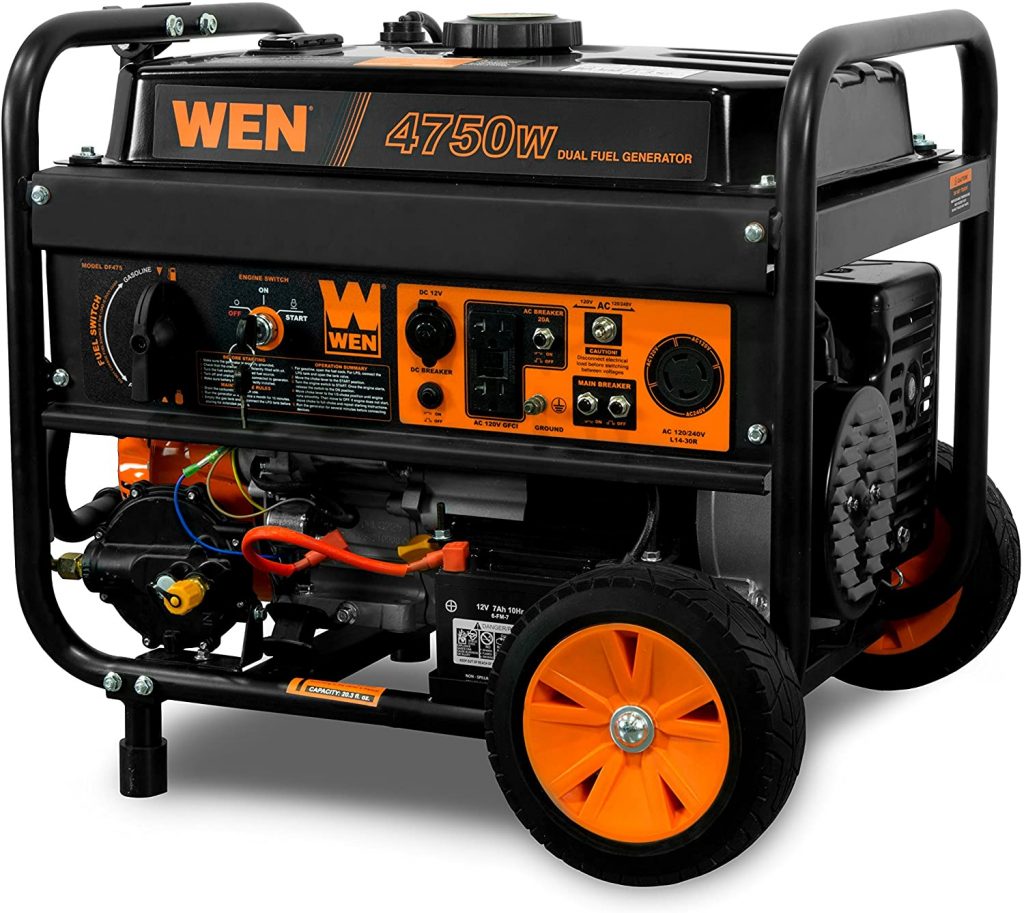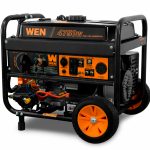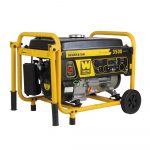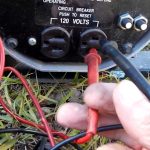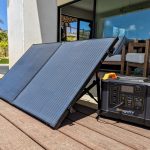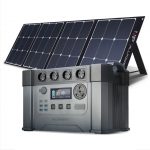If you are looking for a generator to run a 240 volt electrical system, you will need a generator that is capable of providing at least 240 volts of power. Most generators are rated in watts, so you must first determine the total wattage of the equipment you plan to run on the generator. Once you know the total wattage, you can determine the size of the generator you need. The size of the generator will be determined by how many watts you require from the generator to run your equipment. Generally speaking, you will want a generator that produces at least 30% more power than the total wattage of the equipment you plan to run.
For example, if your equipment requires 2400 watts, then you will want to select a generator that can produce at least 3120 watts. When selecting a generator for 240 volts, it is important to make sure it is rated for 240 volts, as some generators may only be rated for 120 volts. It is also important to consider the type of fuel the generator uses, and the noise level it is capable of producing.
What runs on 240 volts in a house?
It is designed to be powerful enough to power essential appliances, like lights, fans, and refrigerators. The generator works by taking the 240 volts of electricity from the power source and converting it into usable power for the appliances in the home. This helps to keep the power running when the power is out. The generator is usually connected to a circuit breaker that allows it to be turned off in the event of an emergency. It can also be used as a backup power source if the main power source fails.
The generator is easy to install and requires minimal maintenance. However, it is important to ensure that it is properly grounded to avoid the risk of electric shock. A 240 generator is a great option for providing power during an emergency or if the power goes out. It is a reliable and safe way to ensure that essential appliances in the home will stay running.
What is difference between 120V and 240V generator?
This is due to the fact that a 240V generator runs at double the line voltage of a 120V generator. This means that the 240V generator can produce more power than the 120V generator, and is a better choice for projects that require more power. The 240V generator also requires fewer components to get the same amount of power. This can make the 240V generator more efficient and cost-effective in the long run. It also means that the 240V generator can produce more power in less time than the 120V generator.
Another difference between the 120V and 240V generators is that the 240V generator is designed to be used with larger appliances. This is because the 240V generator is able to produce more power than the 120V generator and is therefore more suitable for large appliances. The 240V generator also has safety features that make it a better choice than the 120V generator. The 240V generator has circuit breakers and other safety features, which can help protect against electrical hazards. This makes the 240V generator a safer choice than the 120V generator. Overall, the 240V generator is a much better choice than the 120V generator. It is more powerful, more efficient, and safer than the 120V generator. This makes it the ideal choice for projects that require more power or for larger appliances.
Can a generator run 240V?
This type of generator is often used to power machinery, equipment and other electrical systems in industrial and commercial settings. Running a generator at 240V requires a significant amount of power, so it is important to ensure your generator is properly sized before attempting to run it at 240V. It is also important to keep in mind that running a generator at 240V can potentially cause damage to your equipment if it is not designed to handle the power. In order to run a generator at 240V, an appropriate voltage regulator should be used to adjust the voltage output from the generator. Additionally, the generator should be connected to an electrical load that is designed to handle the specific voltage level.
The answer to the question “Can a generator run 240V?” is yes. The key considerations to keep in mind when running a generator at 240V are the size of the generator, the power requirements of the equipment that will be powered and the appropriate safety measures in place. Overall, it is important to make sure that you understand the power requirements of your equipment and that you use the right type of generator and safety controls when running a generator at 240V. This will help ensure that your equipment is properly powered and that it is safe to use.
What is the smallest 240V generator?
It works by converting mechanical energy into electrical energy. The smallest 240V generator is a light-weight and portable device, making it an ideal choice for people who need a reliable power source in remote locations. The smallest 240V generators are typically small enough to fit into the back of a truck or van, making them easy to transport wherever they are needed. They are also often fitted with wheels and handles, making them even more portable. These generators are typically powered by a gasoline or diesel engine, making them much quieter and more efficient than larger generators.
They are also typically capable of producing enough power to run a range of small appliances, including lights, fans, and refrigerators. The smallest 240V generators are usually quite affordable and can provide a reliable source of power for individuals or businesses. They are a great option for those who need an efficient and reliable source of power in remote settings. The smallest 240V generator is a great option for anyone needing a reliable source of power. It is an efficient and cost-effective solution for anyone looking for a lightweight and portable power source.
Will a 3 kw generator run a house?
A 3 kW generator is capable of powering smaller household appliances such as a refrigerator, a microwave, and a few lights, but it is not powerful enough to run a house. For a house to be powered, a much larger generator is needed. For example, a 240 kW generator is capable of supplying electricity to an entire home. A 3 kW generator can keep basic appliances and lights running during a power outage, but for more power, a larger generator with a higher wattage is needed. A 240 kW generator is a large and expensive piece of equipment, so it is normally used in industrial and commercial applications. For a typical home, a much smaller generator with a lower wattage is usually sufficient. 3 kW is a good starting point for a generator to power a home, but it may not be enough in some cases.
Do you need a neutral wire for 240v generator?
When you are using a 240v generator, you will need to make sure that you have a neutral wire. This neutral wire is how the generator connects to the utility system so that it can provide electricity. The neutral wire is a white wire in the cable that connects the generator to the utility system. Without it, the generator will not be able to provide the power needed for the system. In order for the generator to work safely and effectively, it must be properly grounded.
This is done with a neutral wire. This wire will connect the generator to the earth and make sure that any excess energy is safely discharged. Having a neutral wire is important for the generator to work properly. Without it, the generator will not be able to provide the necessary power and could even be a safety hazard. If you are using a 240v generator, make sure that you have a neutral wire in order to make sure that the generator is working safely and effectively. Without it, the generator will not provide the power you need.
How many watts is a 240 volt generator?
Depending on the type and size of the generator, the wattage can range from a few thousand watts to upwards of ten thousand watts. The wattage of a 240 volt generator typically ranges from 2,400 to 9,600 watts. This amount of wattage is typically enough to power a small house, providing energy for lights, appliances, and other electrical needs. For larger homes, it may be necessary to purchase a generator with more wattage. Generally, a generator rated at 9,600 watts or higher will be enough to power a larger home.
It is important to remember that the wattage of the generator is directly related to the voltage of the generator. So, a 240 volt generator will produce a wattage of 2,400 to 9,600 watts. When choosing a generator, be sure to select one with enough wattage to meet your power needs. It is also important to remember that the wattage of a generator is only one consideration when selecting a generator. Other features such as size, noise level, and fuel type should also be taken into account.
Can a 2000 watt generator run a house?
A 2000 watt generator is not typically powerful enough to run a house. However, a 240 generator may be able to handle the task. Generally, a generator with a higher wattage rating is needed in order to power an entire house. The size of the generator you will need will depend on the size and type of appliances you plan to run. Many homes will require a 5000 watt generator or higher to properly power all the appliances.
However, a 2000 watt generator can still be useful for running smaller appliances, such as a refrigerator or TV. You can also use a 2000 watt generator to power outdoor equipment like a pressure washer or a small air compressor. In conclusion, a 2000 watt generator is not strong enough to run a house, but can still be used for smaller tasks. A 240 generator may be able to handle the task of powering a house, but it would depend on the size and type of appliances you plan to use.
How do I get full 240V power from my Generator?
Generating full 240V power from a 240V generator is easy. All you need to do is ensure that the generator is running on full power, and that its output is compatible with the voltage of the devices you are powering. To do this, make sure that the generator’s wattage rating matches the wattage of the devices you are looking to power. If the wattage of the device is higher than the generator’s rating, you need to look for a generator with a higher rating. Once you have a generator of the right wattage, connect the output terminals of the generator to the input terminals of the device you are powering.
You should also make sure all the circuits are connected properly and the power is not being diverted elsewhere. If you are powering multiple devices, make sure to connect the generator’s terminals to each device in the same order, to ensure all power is flowing in the correct direction. If the generator has multiple outputs, you can use these to connect different devices to different circuits. Finally, make sure the generator is connected to a suitable power source, such as mains electricity or a fuel source, to ensure it is running on full power. Once all of these steps are complete, you should be able to get full 240V power from your generator.
How do you install a 240V plug?
First, you will need to choose the right plug for your generator. Once you have found the ideal plug for your generator, you will need to attach it to the generator. This is done by connecting the two wires that are associated with it. You may also need to attach a ground wire to the plug, depending on the type of plug you are using. Next, you will need to plug the cord from the generator into a 240V outlet.
If the outlet does not already have a plug, you can use a 240V plug adapter to attach the cord to the outlet. Once the plug is connected, you will need to turn the generator on and check to make sure it is working properly. If everything looks good, you can then turn the generator off and make sure the plug is firmly connected to the generator. Finally, you will need to test the plug to make sure it is properly installed and that it is working correctly. To do this, you can use a voltage meter to measure the voltage in the outlet. If the voltage is within the acceptable range, then you have successfully installed the 240V plug on your generator.
How to install a 240V circuit breaker?
First, you need to switch off the main power supply to your electrical system. Then, locate the circuit breaker panel and remove the cover. Inside, you will see a set of terminals where the power feeders are connected. Take the appropriate circuit breaker and match its voltage rating to your generator. Secure the circuit breaker in place by tightening the screws. Once it is set, you can connect the two power feeders leading from the generator to the circuit breaker. Lastly, switch on the power supply and test the circuit for proper operation.
What is 240V equal to in Watts?
This type of generator is commonly used in residential and commercial applications, such as powering machinery, tools, and other large appliances. When dealing with volts and watts, watts are a measure of power and volts are a measure of potential difference. Therefore, 240V is equal to 240 watts. This means that a 240V generator is capable of supplying 240W of power. The wattage of a generator is usually determined by the amount of current it can supply to an appliance.
A 240V generator is capable of supplying a large amount of current, which makes it a suitable choice for powering heavy-duty equipment and tools. In addition to providing power to large appliances, a 240V generator can also be used to provide backup power during an outage. This generator is equipped with a built-in alternator which allows it to generate power even when the grid is down. Overall, a 240V generator can be a great choice for powering large appliances or providing backup power when needed. Its high wattage allows it to supply a large amount of current and its built-in alternator gives it the ability to generate power even during an outage.
Can a portable generator run 240 volts?
Portable generators are designed to run on different voltages, including 240 volts. This means that a portable generator can be used to power items such as air conditioners, refrigerators, and other appliances that require a higher voltage. However, it is important to note that portable generators are usually limited in terms of wattage, and so if you are looking to run something that requires a lot of power, a generator with a higher wattage rating may be needed. Also, it is important to use the correct type of power cord when running a 240 volt generator, otherwise, it could cause safety issues. Most portable generators will come with wiring instructions to help you ensure you are using the correct type.
It’s also important to note that it is important to take the necessary safety measures when operating a 240 volt generator, such as having an adequate emergency plan in place, as well as ensuring you are aware of any obstacles or hazards that may be present in the area. Finally, it’s important to properly maintain your generator to ensure it is running safely and efficiently. This includes regularly checking the oil and filter, running the generator regularly, and making sure the fuel tank is topped up. Following these simple tips can help you ensure your generator is running safely and effectively.
How many amps do I need for 240?
To determine how many amps you need for a 240 generator, you need to consider the power of the generator and the voltage that it is designed to supply. Generally, the power of a generator is rated in watts and volts, so you need to determine the wattage of your generator. Once you have determined the wattage, you can divide it by the voltage (240) to determine the amps. For example, if the generator is rated to supply 2,400 watts of power, then you would divide 2,400 by 240 to determine the amps. This would be 10 amps.
If you are unsure of the wattage of your generator, you should consult your generator’s manual or contact the manufacturer for more information. In addition to the wattage, you may also need to consider the maximum load capacity of the generator. This is the maximum amount of power that the generator can safely provide. Generally, the maximum load capacity should not exceed 80% of the wattage rating. Therefore, when calculating the amps for a 240 generator, you should consider both the wattage of the generator and the maximum load capacity. Once you have these two values, you can divide the wattage by the voltage (240) to determine the amps.
How do you convert a 120V to a 240V generator?
The generator must have the ability to have its voltage adjusted, which is typically indicated by a switch or a set of terminals. To convert to a 240V generator, simply switch the voltage setting to 240V or connect the output terminals to the 240V terminals. Depending on the generator, there may also be a need to adjust the frequency for certain loads. It is important to make sure that the generator can handle the increased voltage, so a qualified electrician should be consulted to ensure the generator is safe to use. Once the voltage has been set, the generator should be tested to ensure it operates as expected.
Is there a 240V generator?
A 240V generator works by converting mechanical energy into electrical energy. This is done through the use of an alternator, which uses magnets to generate an alternating current of 240 volts. This voltage can then be used to power a variety of devices. The size and power of a 240V generator will depend on the type of appliance it is being used to power. For example, a generator with a smaller output may be suitable for powering a smaller appliance, while a generator with a higher output may be required to power a larger appliance.
In order to ensure proper operation of a 240V generator, it is important to use the correct wattage of power that is suitable for the device it is being used to power. It is also important to take into consideration the environmental conditions that the generator will be used in, as this can affect the output of the generator. Overall, a 240V generator is a great way to power a variety of devices. With the right wattage and environmental conditions, it can be an effective and reliable source of electrical power.
Why doesn t the US use 240V?
The US doesn’t use 240V when it comes to its power generators because it is not compatible with the American power grid. American households generally use 120V systems, which is not capable of providing a 240V output. The American power grid is designed to supply 120V to residential areas and 240V to commercial and industrial areas. Using 240V in the US would require major changes to the existing electrical system, including new wiring and new transformers. This would create additional costs and require potentially significant downtime in order to safely complete the upgrades.
Another issue with using 240V in the US is that the majority of residential appliances are designed to run on 120V. Using 240V in these appliances could lead to premature failure or other problems due to the higher voltage. Therefore, 240V generators are not common in the US and are not typically used for residential applications. However, they may be used in industrial and other areas where 240V electricity is available.
How do I get a 240V generator?
Depending on your needs, there are various types of generators available, and it is important to select the generator that is right for you. To get a 240V generator, you need to determine the amount of power you need, and then choose a generator that is capable of providing that amount of power. It is important to consider the size of the generator, as well as the features it offers. You also need to ensure that the generator is suitable for the intended use. Once you have selected a generator, you need to install it correctly.
This includes connecting it to the power supply, making sure the wiring is safe and secure, and testing it. It is important to read the manufacturer’s instructions carefully before attempting any of these tasks. When it comes to purchasing a 240V generator, you have a few options. You can buy a new generator from a retailer or an online store, or you can purchase a used generator from a reputable seller. It is important to choose a generator that is certified and meets all safety requirements. Finally, once you have selected and installed your generator, it is important to keep it well-maintained to ensure it runs efficiently and safely. Regularly check the oil and fuel levels, and make sure the connections are secure. Follow these steps to ensure your 240V generator is reliable and efficient.
What is the best portable generator for home use?
It has a wide range of power options, so you can choose the best one for your needs. The generator is durable and reliable, so you can use it for many years to come. It also has a low noise output, ensuring that it won’t disturb your neighbors. Finally, it is fuel-efficient, meaning you won’t have to spend too much money on fuel. All in all, the 240 generator is the perfect choice for any home.
What is the best portable generator brand?
240 generators are one of the most reliable and dependable portable generator brands on the market. They have been providing reliable power solutions for a variety of purposes since their inception in the 1950s. Their generators are designed to be durable and powerful and are perfect for a variety of uses, such as camping, tailgating, and emergency power needs. They feature both gasoline and propane powered units, as well as hybrid models that can run both fuel sources. Their wide range of product offerings, excellent customer service, and competitive prices make them one of the best-rated brands in the industry.
Their generators are easy to set up and use, and their excellent design ensures reliable and long-lasting power. Moreover, the company’s customer service team is highly knowledgeable and always ready to help customers with their generator needs. Overall, 240 generators are an excellent choice for anyone looking for a reliable, powerful, and affordable portable generator. They offer a wide selection of products designed for a variety of uses, as well as exceptional customer service. Thus, they are the best portable generator brand on the market today.
What are the best portable electric generators?
The 240 generator is one of the best portable electric generators on the market. It is small, lightweight and easy to use, allowing for an efficient, effective and portable power solution. This generator is reliable and can provide up to 8,000 watts of power, making it suitable for a variety of applications. It is also fuel efficient, as it can run for up to 8 hours on a single tank of gas. Additionally, it is also very quiet, allowing for a more peaceful power solution.
The 240 generator is also a great choice for emergency power. It is equipped with two 120-volt outlets and a 12-volt outlet, making it easy to power various types of devices. This generator is also equipped with a digital display that shows current voltages, which is useful for monitoring and controlling the power output. Overall, the 240 generator is a great choice if you need a reliable and efficient portable electric generator. It is fuel efficient, quiet and easy to use, making it an excellent choice for both emergency and everyday power solutions.
What is the best portable gas generator?
The 240 generator is one of the best portable gas generators on the market. It is designed to provide reliable power for any situation, whether it be for camping, tailgating, or emergency power. It has a powerful 4-stroke engine and can produce up to 7500 running watts. It also features a durable steel frame and is easy to transport, making it the perfect companion for any outdoor adventure. Additionally, the 240 generator has two 120-volt 20-amp outlets and one 120-volt 30-amp outlet, giving you the flexibility to power multiple appliances or devices.
The 240 generator also features a low-oil shutoff, which automatically turns off the generator when the oil levels are too low. This is a great feature to have if you want to avoid damaging your engine. All in all, the 240 generator is an excellent choice for anyone looking for an efficient and reliable portable gas generator.
